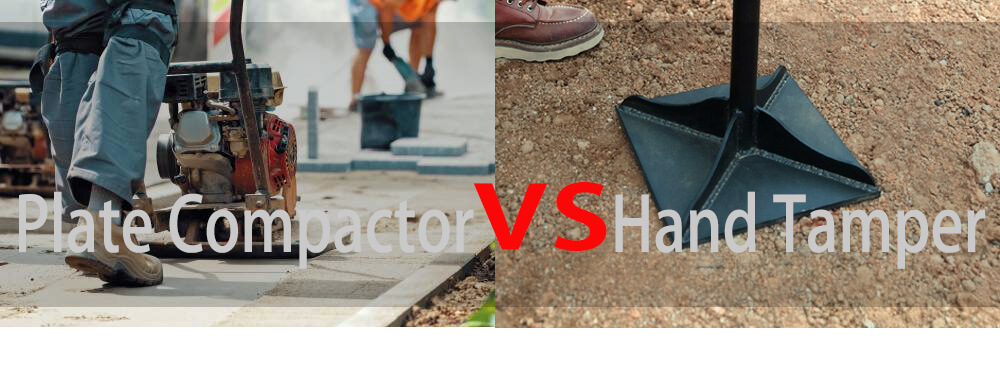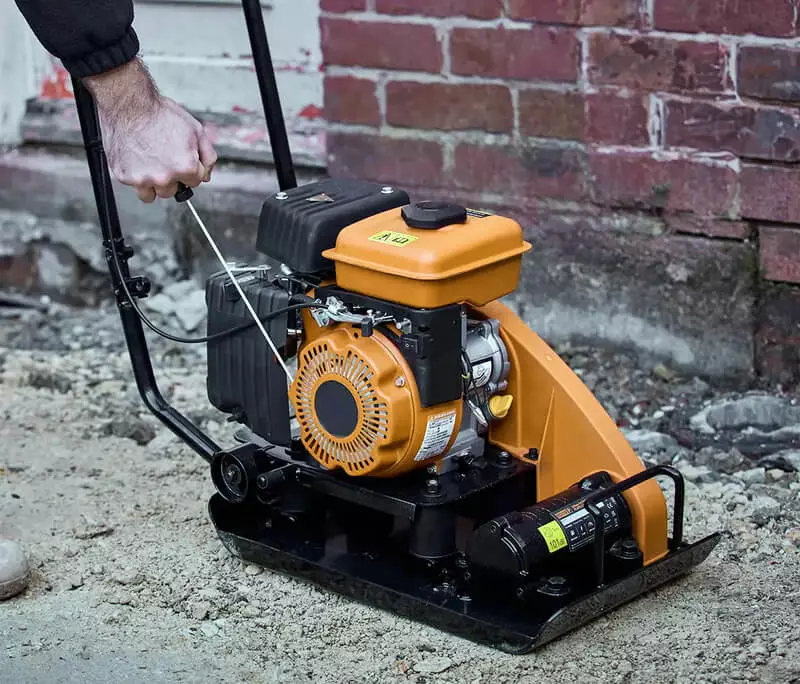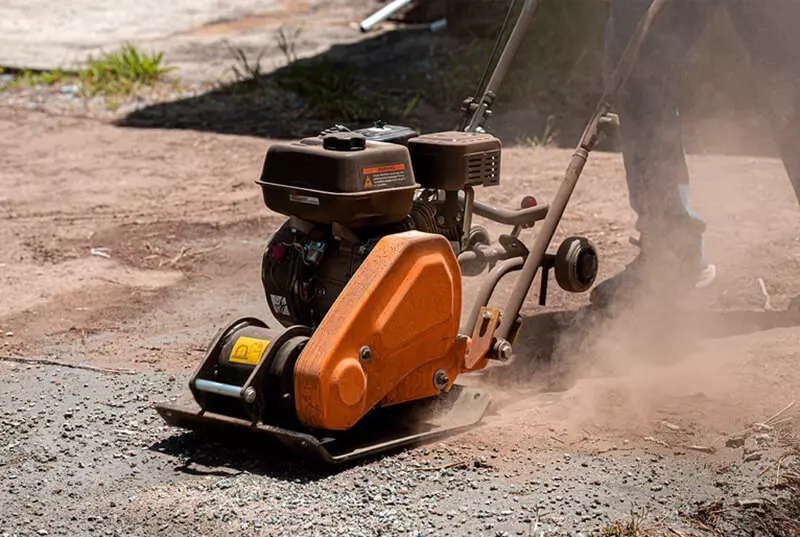20Mar 2024
table of contents
Earth compaction is a critical aspect in construction works. Ensuring a firm, steady base is one of cornerstones of any successful construction project, and effective soil compaction is primary method to attain this stability. Plate compactors and hand tampers play a prominent role in this.
In this guide, BISON delve into a detailed comparison of plate compactors and hand tampers, weighing their unique advantages and potential limitations to help you choose the right compaction equipment for your needs. So if you’re ready to uncover the secrets to efficient soil compaction and make smart equipment decisions, read on and let’s dive in.

Plate compactor is a construction tool, are used to compact soil, asphalt, and other surfaces. Its core elements are a heavy metal chassis, a powerful engine and a complex vibration mechanism. Basically, plate compactors work on the principle of vibration. It uses an electric motor to create strong vibrations that travel from the engine through the floor and into the soil. This vibration stirs up soil particles, rearranging them into a denser, more compact structure, perfect for strong building foundations.
Plate compactors are highly regarded in the construction industry due to several significant advantages:
Efficiency: The most significant advantage of using a plate compactor is its ability to compact ground quickly and evenly. Thanks to its impressive vibration mechanism and larger compaction surface, plate compactor can cover large areas quickly. This indicates a reduction in the time allocated for preparation, allowing for a heightened focus on other important facets of construction project.
Plate compactor's speed of execution is not just vital for meeting tight project deadlines, but it also aids in lowering workforce expenses, rendering it a financially sound choice for big organizations.
Depth of compaction: When building a strong, long-lasting foundation, the depth of soil compaction is critical, long-lasting foundation. With their powerful engines, plate compactors can compact soil to greater depths than many similar products.
This depth of compaction ensures a more stable base for your foundation or paving, which is critical for many types of construction projects, including roads, driveways, patios, and building foundations. It reduces the risk of the ground moving or settling over time, potentially causing damage to the top structure.
Easy to use on large areas: Plate compactors are the best solution for handling large sites as they can cover large areas with ease, ensuring even and consistent compaction across the entire site.
Versatility: Plate compactors are versatile and can effectively handle different types of soil—granular soil, mixed soil, and even asphalt. Some models are also equipped with water tanks and sprinkler systems, allowing them to compact hot-mix asphalt for use in paving or repairing roads, sidewalks and parking lots.
These numerous benefits position the plate compactor as an essential tool in any construction endeavor, particularly those sizable projects which require prompt, uniform, and profound compaction. Although there are certain disadvantages, such as cost, size, and maneuverability, the benefits they provide often far outweigh their limitations.
Although plate compactors are widely used, they have some disadvantages:
Cost: Indeed, plate compactors typically carry a heftier price tag compared to hand tampers. Added with additional expenses for fuel and upkeep, it represents a significant investment.
Size: Due to large size and weight of plate compactor, it is difficult to transport it from one place to another.
Maneuverability in tight spaces: The large footprint of plate compactors makes them less than ideal for operation in compact and cramped environments, where their size and weight require adequate navigation space.
In a comprehensive project of soil compaction, plate compactors bring their fair share of benefits and drawbacks. Understanding these can equip construction professionals and DIY enthusiasts alike with the knowledge to use them most effectively, maximizing their project potential.

A hand tamper is a hand compaction tool widely used in construction and landscaping. The simplicity of its design is one of its main attributes - usually, at first glance, you will see a flat rectangular or square metal base plate connected to a traditional long wooden or metal handle.
To compact soil with a hand tamper, the operator taps the ground hard with the flat end of the tool. The applied pressure causes the soil particles to rearrange and pack tightly together, creating a stronger surface suitable for subsequent construction or paving.
Hand tampers have several unique attributes that make them attractive for certain applications:
Affordable: hand tampers are much cheaper compared to mechanical options like plate compactors. This makes them ideal for budget-conscious DIYers or construction professionals focused on smaller projects.
Portability: Thanks to its compact design, hand tamper machine boasts considerable portability, facilitating effortless transportation from one location to another. Additionally, its compact nature enables easy storage when idle.
Suitable for small areas and tight spaces: Hand tamper excel where other equipment lacks maneuverability. They are ideal for compacting small areas or where access is limited where plate compactors or other larger machinery cannot operate effectively.
While hand tamper have their own advantages, they also have some inherent disadvantages:
Labor Intensive: Manually operating a hand tamper requires a lot of physical effort. As such, it can be labor-intensive and time-consuming, especially for larger areas, which poses real challenges to overall project timelines and efficiency.
Lower effective compaction depth and speed: hand tampers do not have as deep or as fast a compaction as plate compactors. For projects requiring considerable compaction depth and speed, a hand tamper may not be sufficient.
Essentially, hand tampers have their own advantages and disadvantages and have a role to play in construction or landscaping tasks.
There are several key factors that come into play when choosing the perfect tool for your compaction needs. Let’s take a look at the comparison chart, which shows both tools under several such factors:
| Factors | Plate Compactors | Hand Tampers |
| Compacted Soil Type | Suitable for granular soils, but may not work well with clay due to its vibrating nature. | Mainly relies on manpower, suitable for granular soil and clay soil. |
| Project Size | Ideal for large projects requiring speed and efficiency. | Ideal for small jobs or working in tight, hard-to-reach spaces. |
| Applications | Ideal for preparing the foundation for a driveway, paver patio, or large landscaping project. | Ideal for small repairs, post-installation or working around edges and corners of larger areas that have been compacted by a mechanical compactor. |
| User Experience | Requires some expertise to operate effectively and safely. | Its usage is easy, thereby eliminating the need for any training. |
Essentially, plate compactors are capable of compacting larger areas quickly and efficiently, making them the tool of choice for larger projects, such as installing a driveway or laying the foundation for a patio with pavers. However, the performance of a plate compactor can vary greatly depending on soil type, and operating a plate compactor requires a certain level of expertise.
Instead, hand tamper is the perfect tool for smaller projects or for working in tight, inaccessible spaces where a plate compactor cannot operate effectively. Although it is slower and more labor intensive than a plate compactor, hand tamper is simpler and can be used by people with minimal experience in this area.
Therefore, when choosing between the two, it is important to consider the size, scope, and specific conditions of the project as well as your comfort level operating these machines. Careful analysis of these factors can help you make the right choice for your compaction needs.

In this comprehensive exploration, BISON introduce and compare two of most commonly used tools in the industry: plate compactors and hand tampers, each with unique advantages and disadvantages. The key takeaway is to understand the role both devices can play in your work environment, depending on the specific requirements of your project. Choosing the right equipment based on these requirements can pave the way for completing projects more efficiently, ultimately saving time and resources.
For those looking to invest in a reliable plate compactor that balances efficiency and ease of use, we recommend BISON plate compactor. BISON plate compactors come in an array of models, tailored to accommodate diverse project scales and soil classifications.
Thanks for reading and BISON look forward to helping you with your next project. For more information about plate compactors and hand tampers, please feel free to contact us!
inquiry form here
BISON BLOG, All the latest news and views from Bison Machinery.